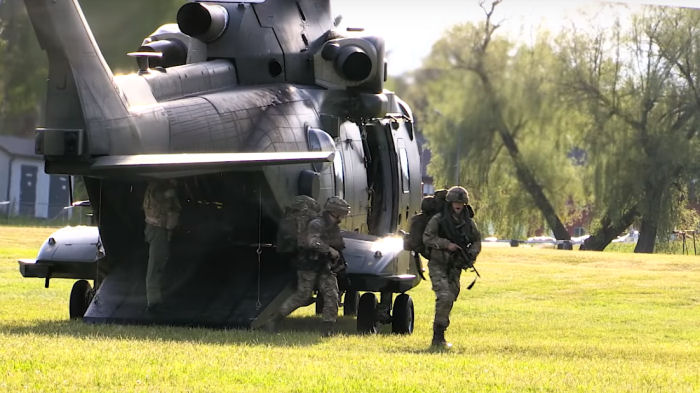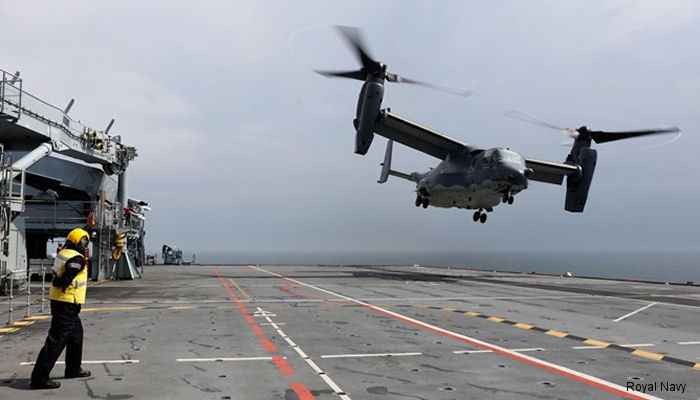Royal Navy, June 21, 2016 - Britain’s flagship HMS Ocean has completed her part in the largest war games staged by NATO in the Baltic.
Over the past two weeks, the helicopter carrier has spearheaded not only the UK’s involvement in Exercise Baltops, but also served as NATO’s flagship – should the alliance be called upon to deal with real world events.
Otherwise, Baltops – this year in its 44th incarnation – is intended to keep the participating forces on their toes, hone their ability to fight alongside each other, and demonstrate collective resolve to protect the independence of nations with Baltic shores.
Baltops is one of the largest (4,000-plus personnel from 17 nations, more than 40 ships and submarines, 60-plus aircraft flying 90 sorties a day and an 800-strong international force of marines) exercises NATO runs – and among the most comprehensive.
After a gentle(ish) start in the Gulf of Finland, the exercise moved up a gear around the Swedish island of Uto, then reached full tilt off the Pomeranian coast of Poland, concluding with an assault on the ranges at Ustka, about 70 miles west of Gdansk.
In each stage – lasting three or four days – more than 100 different manoeuvres or actions were planned, everything from formation flying and sailing to be captured on camera for the media, to Ocean’s Apaches spewing fire and fury from their cannon on Swedish ranges, fast attack craft causing havoc weaving between slow-moving minehunters which had to simultaneously fend off low-flying jets and convoys cautiously moving through minefields.
There was the impressive sight of the US Air Force’s legendary B-52 bombers dropping practice mines into the waters around the Danish island of Bornholm.
And there was the impressive sight of said mines being blown up by the minehunters of NATO’s Standing Group 1, including HMS Pembroke.
There was the unusual sight of HMS Iron Duke playing the bad guy, leading a force of four German patrol boats, a Lithuanian warship and a tender determined to upset the actions of Ocean and the allied forces, harrassing NATO vessels and stoking the flames of unrest by pumping out propaganda.
As flagship, Ocean found herself home to Italians, French, Germans, Spanish, Swedish and Americans, while her flight deck and hangar were filled with submarine-hunting Merlins from RNAS Culdrose, Royal Marines-carrying Merlins from Yeovilton, two RAF Chinooks from 27 Squadron, and four Army Air Corps Apaches.
While the latter gunships let rip on the ranges, the Chinooks and Merlins were called on to ferry Italian marines ashore, while Ocean’s own landing craft deposited Royal Marines from the Commando Training Centre at Lympstone on to Swedish soil.
“Baltops is the exercise that just keeps giving; it’s bigger and better each year,” said Col Garth Manger Royal Marines, a senior operations officer.
“This year we had over 4,000 sailors and marines operating in 43 different ships from 17 nations, all honing their professional skills and making lasting partnerships.
We left our footprint in the Baltic – moving from Estonia, through Finland and Sweden, and into Poland, then finishing in Germany. Our successful ability to operate with each other goes a long way in showing our collective resolve to maintain the peace and security in which this area thrives.”
For Britain’s biggest warship, Baltops was a most useful to her impending amphibious deployment when she leads the RN’s Joint Expeditionary Force – Maritime to the Mediterranean in the autumn.
“The embarkation of helicopters from all three Services and Royal Marines, as well as Ocean’s role as a command ship for NATO staffs, ensured that she benefited from developing her capability across the spectrum of war fighting disciplines,” said her second-in-command Cdr Nick Wood.
They were, sadly, stymied somewhat on the final day of the exercise – the big set-piece landings at Ustka in front of military and political leaders as low cloud descended; it fell to a mixture of British and American landing craft, amphibious vehicles and hovercraft to plug the gap – proving the ability of the international force to chop and change at the last minute – and still achieve its goal.
That was something which delighted the American vice admiral choreographing the entire two-week exercise, James Foggo III.
He was impressed by the way different nations, with different equipment, different ways of working and different languages fitted together to make Baltops 2016 “extremely successful”.
He added: “Similar to trust, you can’t surge interoperability—we have to train together to operate together seamlessly. We are committed to Baltic security and have already starting planning Baltops 2017.”
With the exercise completed, most of the participating warships headed for Germany and Kiel Week, the world's largest maritime/sailing festival.
Over the past two weeks, the helicopter carrier has spearheaded not only the UK’s involvement in Exercise Baltops, but also served as NATO’s flagship – should the alliance be called upon to deal with real world events.
Otherwise, Baltops – this year in its 44th incarnation – is intended to keep the participating forces on their toes, hone their ability to fight alongside each other, and demonstrate collective resolve to protect the independence of nations with Baltic shores.
Baltops is one of the largest (4,000-plus personnel from 17 nations, more than 40 ships and submarines, 60-plus aircraft flying 90 sorties a day and an 800-strong international force of marines) exercises NATO runs – and among the most comprehensive.
After a gentle(ish) start in the Gulf of Finland, the exercise moved up a gear around the Swedish island of Uto, then reached full tilt off the Pomeranian coast of Poland, concluding with an assault on the ranges at Ustka, about 70 miles west of Gdansk.
In each stage – lasting three or four days – more than 100 different manoeuvres or actions were planned, everything from formation flying and sailing to be captured on camera for the media, to Ocean’s Apaches spewing fire and fury from their cannon on Swedish ranges, fast attack craft causing havoc weaving between slow-moving minehunters which had to simultaneously fend off low-flying jets and convoys cautiously moving through minefields.
There was the impressive sight of the US Air Force’s legendary B-52 bombers dropping practice mines into the waters around the Danish island of Bornholm.
And there was the impressive sight of said mines being blown up by the minehunters of NATO’s Standing Group 1, including HMS Pembroke.
There was the unusual sight of HMS Iron Duke playing the bad guy, leading a force of four German patrol boats, a Lithuanian warship and a tender determined to upset the actions of Ocean and the allied forces, harrassing NATO vessels and stoking the flames of unrest by pumping out propaganda.
As flagship, Ocean found herself home to Italians, French, Germans, Spanish, Swedish and Americans, while her flight deck and hangar were filled with submarine-hunting Merlins from RNAS Culdrose, Royal Marines-carrying Merlins from Yeovilton, two RAF Chinooks from 27 Squadron, and four Army Air Corps Apaches.
While the latter gunships let rip on the ranges, the Chinooks and Merlins were called on to ferry Italian marines ashore, while Ocean’s own landing craft deposited Royal Marines from the Commando Training Centre at Lympstone on to Swedish soil.
“Baltops is the exercise that just keeps giving; it’s bigger and better each year,” said Col Garth Manger Royal Marines, a senior operations officer.
“This year we had over 4,000 sailors and marines operating in 43 different ships from 17 nations, all honing their professional skills and making lasting partnerships.
We left our footprint in the Baltic – moving from Estonia, through Finland and Sweden, and into Poland, then finishing in Germany. Our successful ability to operate with each other goes a long way in showing our collective resolve to maintain the peace and security in which this area thrives.”
For Britain’s biggest warship, Baltops was a most useful to her impending amphibious deployment when she leads the RN’s Joint Expeditionary Force – Maritime to the Mediterranean in the autumn.
“The embarkation of helicopters from all three Services and Royal Marines, as well as Ocean’s role as a command ship for NATO staffs, ensured that she benefited from developing her capability across the spectrum of war fighting disciplines,” said her second-in-command Cdr Nick Wood.
They were, sadly, stymied somewhat on the final day of the exercise – the big set-piece landings at Ustka in front of military and political leaders as low cloud descended; it fell to a mixture of British and American landing craft, amphibious vehicles and hovercraft to plug the gap – proving the ability of the international force to chop and change at the last minute – and still achieve its goal.
That was something which delighted the American vice admiral choreographing the entire two-week exercise, James Foggo III.
He was impressed by the way different nations, with different equipment, different ways of working and different languages fitted together to make Baltops 2016 “extremely successful”.
He added: “Similar to trust, you can’t surge interoperability—we have to train together to operate together seamlessly. We are committed to Baltic security and have already starting planning Baltops 2017.”
With the exercise completed, most of the participating warships headed for Germany and Kiel Week, the world's largest maritime/sailing festival.
See also |
HMS Ocean Departs for BALTOPS 2016






